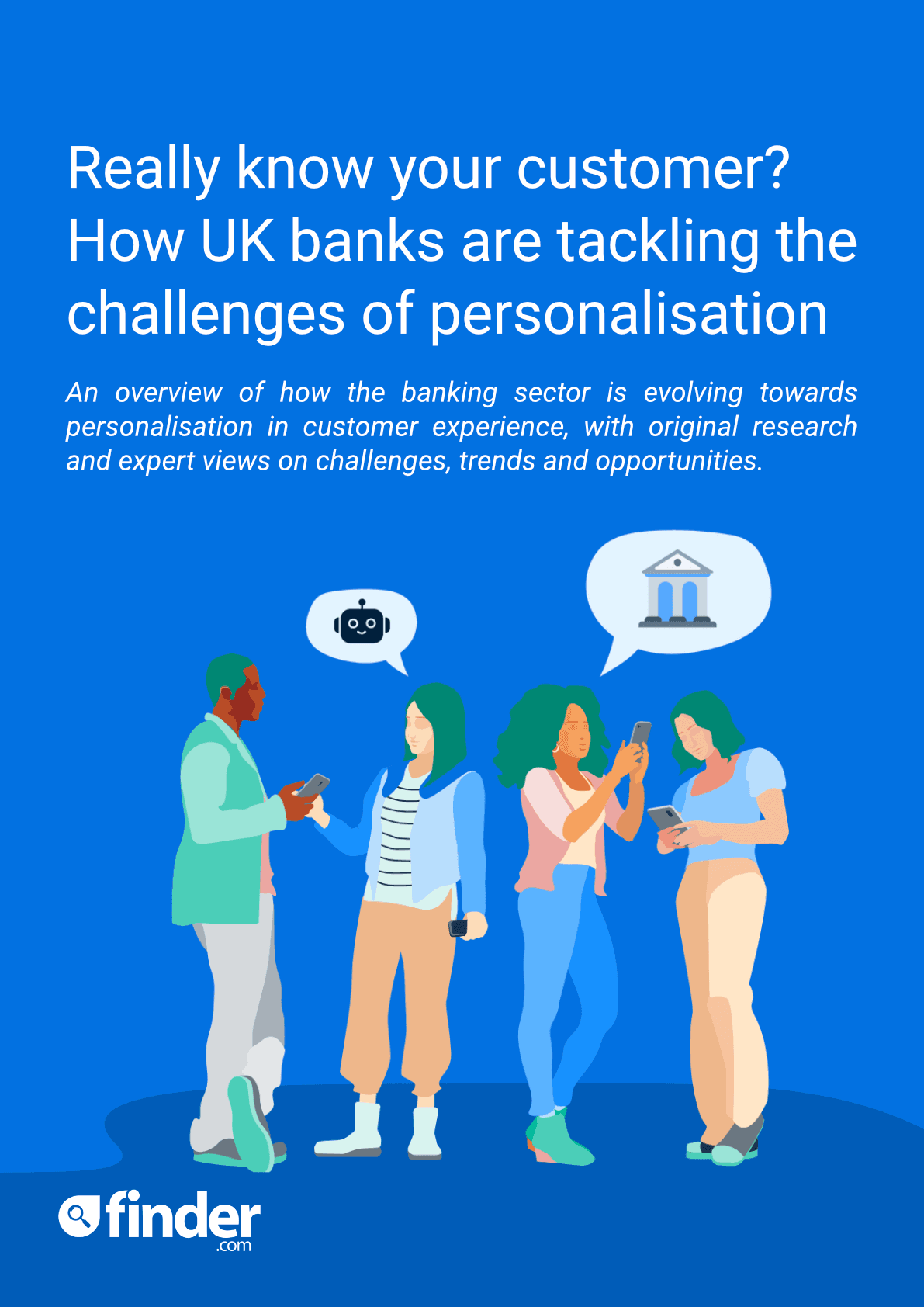
Bank and e-money accounts have different overdraft rates and some pay interest on your balance. Use the filters to choose account types and brands, and table headings to sort your results on what matters most to you.
Finder Score for bank accounts
To make comparing even easier we came up with the Finder Score. Fees, features and customer service across 20+ of the most popular banks are all weighted and scaled to produce a score out of 10. The higher the score the better the account – simple.
Read the full methodologyWhat’s a current account?
A current account is a bank account that gives you instant access to your money and that you can use for your day-to-day financial life. It lets you receive your salary, pay your bills, make purchases, and send and receive payments; many accounts offer all this for free. You’ll get an account number, a sort code, a debit card and usually an internet banking service, mobile app or both. Typically, you won’t get a great interest rate on money you’ve deposited in a current account, but most offer an overdraft (which will cost you in interest charges).
While accounts’ basic functions are similar, there are some key differences when it comes to interest rates, customer service, online and app features and, of course, switching incentives like free money. One major difference is that some accounts are protected by the Financial Services Compensation Scheme (FSCS), and some aren’t. The FSCS protects deposits up to £85,000 in your account if you bank goes bust.
Current account jargon explained
Funding requirement. Some accounts require you to pay in a certain amount regularly – for example, every month – to qualify for perks, or even to be eligible for the account. It’s a way of ensuring you pay in your salary.
AER. Annual equivalent rate. This is a way of showing the interest you’d earn in a year on money you deposited into an account, and helps you to compare accounts.
EAR. Equivalent annual rate. This is the interest rate that applies when you borrow money – when you use your arranged overdraft, for example. It shows the interest you would be charged over a year if your account were to remain overdrawn.
Arranged overdraft. If your account goes into the red, the bank will charge you a set EAR. Before you go overdrawn, you need to arrange this facility with your bank.
How to compare current accounts
The best current account for a school leaver in their first job may not the best one for a frequent traveller with complex financial needs, so you’ll have to figure out which banking features are the most important to you.
Here’s our checklist for how to find the right current account for you.
- Check the ways you can bank. Do you need an extensive branch network that you can visit in person, or are you happy to manage all of your finances online or on a mobile app? And if your bank doesn’t have branches, can you still access customer support at a time that suits you?
- Check the features. Some current accounts offer fairly basic features, which is fine if you just need your salary to be paid in and your bills to be paid out. But if you’re looking for a slick mobile app, spending categorisation and budgeting tools, or the ability to arrange an overdraft easily, you’ll need to make sure the account offers all that. You might also decide you want an account with FSCS protection, and many accounts in our table offer this.
- Check the fees and costs. With free current accounts (all major high street and digital banks offer these), there can still be charges for certain types of transaction, such as using your card overseas, or even paying cash into your account if you’re with a mobile-only bank. If you’ll need an overdraft, confirm what interest rate you’ll pay.
- Check if a “packaged” or “premium” account would be better value. Some accounts charge a monthly fee in return for a “package” of extra benefits such as mobile phone and travel insurance, breakdown cover or cashback on your bills. These are only worth getting if you would use the benefits and have checked standalone policies wouldn’t be better value for you.
- Is there a joining or switching incentive? Banks are vying for customers and they often have tasty offers on the table to get you to sign up, or to switch your current account from your existing provider. The most popular incentive is (unsurprisingly) a cash lump sum, so if you’re considering a new current account anyway, you might be able to make a bit of money from it too. But factor the rest of the checklist points into your decision, particularly if you’ll need an overdraft.
Current switching deals
Below we have listed the latest switching deals on the market. This list is checked regularly and was last updated on 14 April 2025.- NatWest – NatWest Reward accounts – Get £150
- first direct – 1st account – Get up to £175
How to switch current account
If you’ve had your current account for years, the idea of switching may sound daunting – many people stick with bad deals just to avoid the hassle. However, the process is in truth quite simple thanks to the Current Account Switch Service (CASS).
Any banks signed up to CASS will switch over your account for you in 7 working days. You don’t need to do anything, except pick out your new current account and decide on a switch date. Here’s how it works:
- Your balance and recurring payments are automatically transferred to your new account. This includes both direct debits and standing orders.
- Your old account is closed. Your transaction history will not be transferred to your new account, so it’s a good idea to make sure you’ve got all your bank statements first.
- Incoming payments to your old account will be redirected. A message with your new bank details is also automatically sent to the payer.
Depending on what your new bank is offering at the time, switching through CASS may also allow you to access switching bonuses and rewards. Most current account switches are done online but there are still a few banks that aren’t part of CASS, like Kroo.
Have you thought about a mobile-only bank?
Digital banks and banking apps like Monzo, Starling. or Revolut have stolen the headlines in fintech for the last few years. In the Finder office we’re big fans – here’s why:
- Cool features. The best thing about them. Digital banks are constantly evolving and adding interesting features. The whole experience feels more user-centred and it’s easier to keep an eye on your spending, make budgets, and personalise the whole thing too.
- Easy to set up. You just download the app, enter your data and confirm your identity. It usually takes less than 10 minutes.
- No fees. This usually also applies to spending abroad.
Types of current accounts
Apart from standard current accounts that prioritise one feature or another, there are also dedicated types of current accounts to suit other specific needs:
- Joint current accounts. Most current accounts can be opened together with another person (your partner, another member of your family, a friend). Just be aware that this creates a financial association between the two of you, which may potentially impact your credit score. Learn more on joint accounts here.
- Bad credit. Most banks perform a credit check when you apply for a current account. If your credit score is less than ideal, you may still be offered an account, but you may not get an overdraft. Learn more on current accounts for people with bad credit.
- Student accounts. If you’re a student, you can bag great perks and rewards and a interest-free overdraft with a student current account.
- Children accounts. In order to be eligible for an adult current account, you usually need to be 16 or 18. However, children current accounts are available to kids as young as 11. There are also children’s prepaid cards that a parent can load money onto and control but these are not current accounts.
- Business accounts. If you run a limited company or are a sole trader, it’s a good idea to keep your business finances separate from your personal finances. You can do this with a business current account. If you’re interested in freelance bank accounts, check out our guide on best business bank accounts for freelancers.
- Sharia-compliant accounts. If you want to bank more ethically, opening an Islamic bank account is an option worth considering. Learn more about Sharia-compliant accounts.
Potential current account fees and costs
When picking a new current account, check all the potential costs. Here are some of the fees you may come across:
- Monthly fee. Most current accounts are free, but some will charge a monthly fee, especially if they offer special perks and benefits.
- Foreign transaction fee. Many debit cards charge a fee when you spend in a currency other than sterling. The foreign transaction fee often amounts to around 3% of the transaction. If you want to avoid it, you could consider having a dedicated account for when you’re travelling – digital banks like Monzo and Starling don’t charge foreign transaction fees.
- ATM withdrawal fee. Withdrawing cash may come with a fee with some current accounts, especially if you do it overseas.
- International money transfer fees. Sending or receiving money in a currency other than sterling is likely to be quite expensive with a standard current account. You may want to consider a money transfer service instead.
- Cheque fees. There’s usually a pretty hefty fee for cancelling a cheque.
- Overdraft charges. Overdrafts tend to be costly. Always check how much your bank charges before using yours. We’ve outlined two examples below showing how the cost of a £500 overdraft can vary, depending on what EAR (effective annual rate) your bank charges you. The difference can be huge – you’d save £100 a year in interest on an overdraft of £500 if you picked an account with an EAR of 15%, compared to a rate of 35%.
Overdraft: £500
- EAR = 15%
- Cost for 7 days: £1.34
- Cost for 30 days: £5.78
- Cost for 90 days: £17.53
- Cost for 365 days: £75.01
Overdraft: £500
- EAR = 35%
- Cost for 7 days: £2.89
- Cost for 30 days: £12.49
- Cost for 90 days: £38.40
- Cost for 365 days: £175.00
Bottom line
Current accounts are an essential tool to manage your daily finances. They provide a means to receive your salary and benefits, and enable you to make payments, pay your bills and build your credit history.
There is no one size fits all when it comes to getting a current account, so be sure to do your research to find an account that best suits your circumstances.
When comparing accounts to find the best option for you, there are a variety of factors to consider, including overdraft terms, online banking facilities and customer service quality.
Some accounts, including packaged bank accounts that offer perks like insurance, come with monthly fees, so it’s a good idea to factor in these charges when making a decision.

Really know your customer? How UK banks are tackling the challenges of personalisation
Finder published a paper in May 2024 exploring how the UK banking sector is tackling personalisation in customer experience. Our paper includes original research, plus insights from Kroo’s CTO Alexey Gabsatarov, Anette Broløs and Erin B Taylor of Finthropology, Nicole Perry of Monument, Isaac Robertson-Jonas of Finder and professor of finance Timothy King.All the content may be republished with a link to this page
Press enquiries
Frequently asked questions
Read more on Current Accounts
-
Cash usage in the UK: Statistics for 2025
Will we eventually become a cashless society? We look at the latest cash usage statistics and trends for 2025.
-
Best banks and bank accounts in the UK 2025
Use our guide to compare the best banks in the UK and find out how to choose the right bank account for your needs.
-
Best current accounts & debit cards with cashback in the UK 2025
Learn how current accounts with cashback work, whether they’re right for you and how to find the best current account.
-
Opening a bank account with no credit check
Having bad credit isn’t ideal, but at least when it comes to bank accounts, you have a range of options. We’ve explored them to help you find the best one.
-
Best bank accounts with cheap or free overdrafts in the UK 2025
Learn all you need to know about your current account’s overdraft, from costs and fees to how to apply for one.
-
Best joint bank accounts in the UK for couples and friends 2025
Ready to take the plunge and open a joint current account with your other half? Learn how they work, how to open one and what happens if you split up.
-
Best high interest current accounts in the UK 2025
Getting a good rate on your account balance is hard but not impossible. We’ve looked at the advantages and catches of high interest current accounts.
-
Lloyds current accounts for April 2025
Are you considering a bank account with Lloyds? Check out its currents accounts, compare options and learn what benefits it offers.
-
Nationwide current accounts for April 2025
Nationwide has one of the most competitive current account offers available on the market. Discover their features, compare options and apply.
-
TSB current accounts for April 2025
TSB offers a range of current accounts that are especially suitable for consumers who are at the beginning of their financial journey – and some of them even pay an interest on balances.
